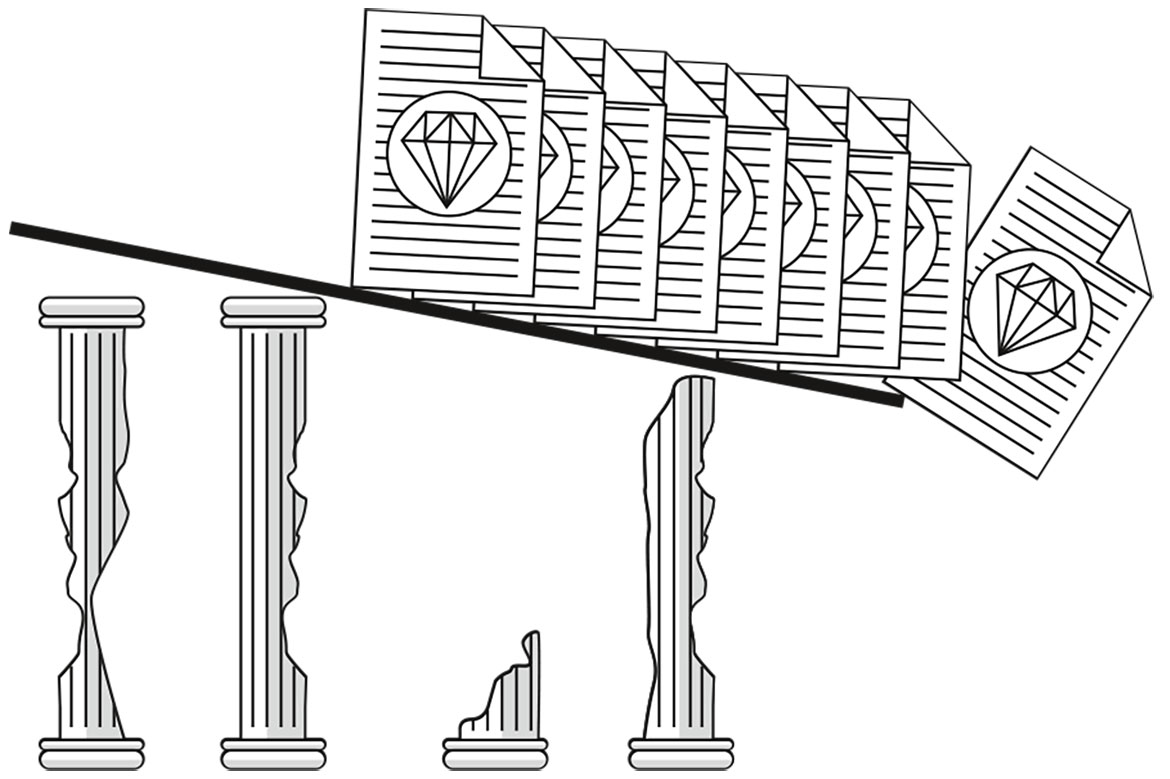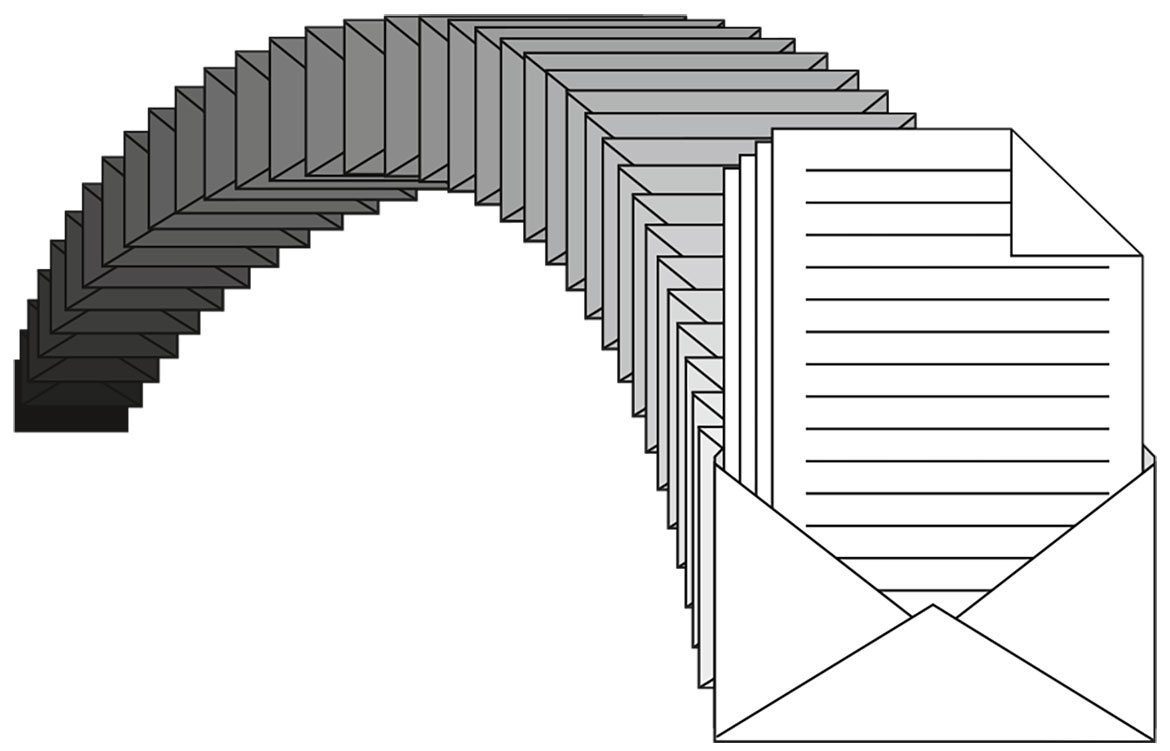FEATURE: A TRANSITION IN PUBLISHING
Five new trends from Switzerland
The world of scientific publishing is evolving, particularly through Swiss initiatives. We provide an overview.

The Swiss Medical Weekly’s ‘diamond’ open access depends on funding from temporary members. | Illustration: Anna Haas
No subscription or publication fees
The Swiss Medical Weekly (SMW) proudly follows the ‘diamond’ path of open access: both reading and publishing are completely free. It does not want to charge authors, as “income would then depend on the number of articles published, which would encourage accepting more submissions and thus lower quality”, explains its director Natalie Marty.
Switzerland’s leading medical science journal therefore depends almost entirely on funding from the 20 or so member institutions of the supporting association – mainly hospitals and medical associations, including the Swiss Medical Association FMH. Universities and the private sector are absent. “The latter would be likely to weaken the journal’s image of independence”, explains Marty. “The hospital community quickly recognised the value of a medical journal that deals with the local situation and publishes articles written by medical researchers. Our editors give a lot of feedback to improve manuscripts, which contributes to the training of scientists at the beginning of their careers”.
Support is planned for three years, which entails an ongoing search for new members. According to Marty, it is “a start-up business model that is not sustainable in the long term”. The SMW editor-in-chief Adriano Aguzzi of the University Hospital Zurich outlined his vision in Nature in 2019: research funding agencies, such as the Swiss National Science Foundation, should provide financial support to diamond open access journals in a competitive manner, judging by, for example, manuscript acceptance rates, deadlines, archiving, retraction management and innovations, e.g., post-publication peer review. This list resembles the strengths of SMW: the journal rejects 70 percent of submissions received, but delivers peer review reports in an average of three weeks and duplicates its content in the CLOCKSS public archive, a tool that ensures that published articles remain accessible in the event that – alas – the journal had to close down.
The SMW celebrates its 150th anniversary in 2021 and seems to be running smoothly, with an average cost of CHF 1,700 per article published. It even sometimes commissions an external evaluation of the statistics presented in manuscripts, and pays a symbolic CHF 50 for the work of the reviewers.

Online multimedia anthologies of poetry could enable us to discover new worlds. | Illustration: Anna Haas
Poetry reinvents academic publishing
Digital scientific publishing is still often content to put articles online in text form or as static PDF files. And a glance at the interactive academic books of the Geneva-based publisher Metispresse is disappointing: after installing ad-hoc reading software, one discovers an unreadable text with jumbled characters and poor interactivity.
A poetry specialist from the University of Lausanne wants to change that. Antonio Rodriguez is developing multimedia anthologies of poetry online. “Traditional printed versions are determined by a single choice – a classification of the poems that can be thematic, historical or geographical”, he says. “Our digital versions allow for the exploration of new combinations and hence unprecedented critical analyses”. Another initiative of his team: to develop an interactive dictionary of 24 concepts of poetic analysis, so that they can be compared in different languages.
But these innovations can run up against institutional obstacles, e.g., obtaining digital object identifiers, or DOIs. Here’s an illustration: the Lausanne team wants to publish its work on the primitivism movement in poetry in the form of an interactive catalogue of contributions. But the SNSF did not support this financially, says Rodriguez. The institution seems to fear an unprofessional platform of unsatisfactory quality and refers to traditional publishing houses, while they “only timidly engage in this kind of interactive project”.
To innovate, you have to think outside the box in scientific publishing. “There are some barriers to innovation in Switzerland, but there is also a lot of encouragement”, says Rodriguez. “After all, two of my team’s three interactive publishing projects have been completed. I see us as pioneers, but also a bit as guinea pigs. We discover and solve problems as we go along. Sharing our experiences is very important: our goal is not to innovate for the sake of innovating, but to implement new and sustainable ways of presenting scientific information”.

Commercial open-access publishers generate their income from publishing fees. Quantity makes for good business. | Illustration: Anna Haas
A Swiss heavyweight that is the source of debate
Two of the biggest open access players in the world are in Switzerland. MDPI is based in Basel and has published 166,000 articles in 2020 (an increase of 51 percent compared to 2019). Frontiers is based in Lausanne and published 48,000 articles in 2020 (up 45 percent).
Could MDPI’s spectacular rise be linked to the dubious practices associated with predatory journals? This is the question posed by the economist Paolo Crosetto in his blog. He notes that MPDI’s growth is mainly due to the advance of its Special Issues: releases compiling articles around a particular theme under a guest editor from that scientific field. In 2020 it counted a staggering average of 100 Special Issues per journal, with the journal Sustainability having over 3,000, compared to its usual 24 issues per year.
Recruiting the thousands of guest editors involves sending out mass emails – a practice that is particularly disturbing when they land on the desks of scientists working in fields far removed from the one being sought. In turn, invited editors have to convince colleagues to submit papers, which generates another flood of emails. “Like any digital company, we use email to identify and communicate with our customers”, says Stefan Tochev, MDPI’s head of communications. “We want to motivate scientists to stimulate discussions in their community”.
Christos Petrou of Scholarly Intelligence notes in an analysis that MDPI has improved its reputation, now rejects 60 percent of submitted manuscripts, and offers unparalleled speed to market with an average publication time of less than six weeks - an advantage that may attract authors.
Online, the community’s opinions are divided. Some say they have had good experiences with MDPI, whereas others have decided to stop evaluating submitted manuscripts, complaining of pressure to accept a large proportion of articles. This is the crux of the problem: commercial open access publishers derive their income from publication fees charged for each article published. Their shareholders - and management - are therefore motivated to get as many as possible.
Despite the criticism levelled at them, the two Swiss companies Frontiers and MDPI are in third and seventh place among the most cited publishers, ahead of competitors with impeccable reputations, e.g., Springer Nature and Oxford University Press.

Publishing one observation after another was supposed to accelerate research and make it more honest. | Illustration: Anna Haas
The start-up that thought it could revolutionise publishing
The idea is appealing. The journal Matters, launched in Zurich in 2016, publishes only individual scientific observations. This allows scientists to communicate their results bit by bit, without waiting to accumulate enough to write a full article. It speeds up research, reduces the temptation to embellish one’s messages and encourages the publication of incremental, unspectacular and negative results. The journal earns income from publication fees (CHF 150 per observation) and annual fees ranging from CHF 5,000 to 50,000, granting a university the right to publish 50 articles.
The results are mixed. In November 2021, the journal’s website, sciencematters.io, had been down for several months and emails were not being delivered. “We had a problem with the automatic renewal of the internet domain name”, says the director Lawrence Rajendran, a neuroscientist now based in London. “This should be resolved soon”. It’s a major problem. Unless the articles have been archived elsewhere by the authors, they are no longer accessible, which is the last straw for an open access publication. Furthermore, the model doesn’t seem to have caught on, with only 150 observations published since launch. “That’s too low, of course. In fact, it’s less than the number of people I’ve talked to in developing the project”, says Rajendran.
How does he explain this failure? “I see a great deal of hypocrisy in the academic world”, he says. “On the one hand, institutions say they want to change the system, to promote open access and the sharing of research data. On the other hand, they encourage their staff to publish in prestigious journals in order to raise their profile and chances of funding. Even the people who supported Matters submitted very few submissions there, for fear of not being able to publish a paper elsewhere later”.
Scientists close to the project criticise the chaotic management and the fact that certain projects were prioritised that supposedly did not deserve it, e.g., the development of a blockchain-based system. Was it sensible to pursue an academic career while running a start-up? “I had to learn everything for Matters, a huge project, and one for which I never paid myself a salary. My hope was that a major Swiss institution would use Matters to launch its own publication. In retrospect, I should have tried an alliance with large publishers like Elsevier and Springer Nature”.

An algorithm can condense different parts of a work into an abstract more honestly than the authors themselves. | Illustration: Anna Haas
When the machine writes the summary
Richard Hahnloser, a professor of neuro-informatics at ETH Zurich, is developing artificial intelligence algorithms to make it easier to write scientific papers. “Writing is a very interesting task when it comes to sharing what you know. But it can be boring when you have to look for the right reference in the literature, download it, insert it in your reference software, annotate it... this slows down creative thinking. That’s my main motivation for this project”.
His team is developing a text editor that enables real-time bibliographic searches. In addition to the keywords employed in the usual tools, the prototype exploits extracts from the text written on the platform that the user selects. The algorithm then ranks the articles identified in the literature according to their degree of semantic similarity with the selected passage – an approach that differs from the usual engines, which are based on the number of occurrences of keywords.
“You can quickly identify the right references without having to play with different combinations of keywords”, Hahnloser says. “This is useful when writing the introduction to an article – a section containing many, many references to previous work – or when writing a research plan in a new and unfamiliar field and needing to identify relevant studies”. To perform the semantic comparison, the prototype uses a language model – similar to the well-known GPT-3 – that summarises any text into a vector characterised by 256 parameters; the distance between two vectors signals how closely the meanings of the two texts are related.
His team is also developing algorithms that summarise scientific articles. These will enable researchers to trawl through the literature without having to read whole articles. “The abstracts written by the authors are sometimes more about convincing their colleagues to read the article rather than summarising its content in a clear, understandable and honest way. Our automated abstracts are generally accurate and informative. In fact, we tested our algorithm on the article that explained how it works: I found the result better than the one I had written myself. I realised, but a little too late, that we could have actually used our automated summary in the published version!”
Illustrations: Anna Haas




